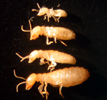| LIFE CYCLE INFORMATION |
|
SUBTERRANEAN TERMITE DESCRIPTION: Termites are small, pale colored insects. They live in colonies. The Workers and soldiers do not have wings, but the fertile males and females do have long , thin wings. HABITAT: Termite damage is usually first seen at or near the ground. However, damage can occur far above ground if the infestation has remained undetected for a long period. Termite damaged wood has no sawdust associated with it, but, the wood does contain mud tubes and the galleries are lined with soil. Termite damage is sometimes located in wood adjacent to heaters or fireplaces. Perhaps, the soil in these areas remains at a higher temperatures during the winter, or the drainage around fireplaces is poor and the soil remains moist for long periods. LIFE CYCLE: A mature queen can lay thousands of eggs each year. The worker termites tend the eggs. The nymph hatches directly from the egg. Attendants feed nymphs regurgitated food for the first two weeks, enabling them to grow. The will become workers, soldiers, reproducers, or supplementary reproducers. TYPE OF DAMAGE: Termites actually eat wood and cause physical damage. Termites often attack the wood that is touching or close to soil. The queen can live for up to 10 years. CONTROL: In some cases the application of termiticides in and around the home bound pipes, wells, and heating ducts may require a professional. In a lot of cases the soil treatment can vary easily be done by the homeowner. DRY WOOD TERMITES Dry wood termites generally live, feed and nest in and under decayed wood which has a very low moisture content. Unlike subterranean termites, they do not require any contact with the soil in order to live. Thus they can seriously damage movable wooden objects such as furniture. In the United States they are found in a narrow strip from Virginia, south to Florida, along the Gulf of Mexico and from Mexico to Northern California on the Pacific coast. A male and female pair work their way into the wood chosen for the nest. The opening through which they enter the wood is sealed with a plug of brown cement-like material about1/8 inch in diameter. Behind this plug they excavate a chamber where the queen lays the first eggs. The nymphs that hatch from these eggs perform the work of the colony. Soldiers and reproducers develop from these nymphs. TYPE OF DAMAGE: Damage done by dry wood termites is entirely different fro that caused by subterranean termites. These termites cut across the grain of the wood, excavating large chambers that are connected by small tunnels. The chambers and tunnels being used by the colony are kept clean. Execrate and other debris are stored in unused chambers or cast out through small openings in the wood.
ROTTEN WOOD AND DAMP WOOD TERMITES This group contains some of our largest termites, with bodies as much as one inch long and wings at least twice that in length. Damp wood termites do not require contact with the soil in order to obtain moisture; however, wood with a high degree of moisture is needed. They are usually associated with wood decay. They plug openings into the wood and excavate large galleries, as do dry wood termites. They do not, however, keep the galleries clean. Their pellets can be found throughout their tunnels in infested wood, although many of the six sided pellets are discarded from the galleries through small openings in the surface of the wood. POWDER POST TERMITES Powder Post Termites live in dry wood. They damage structural timbers as well as furniture. They enter wood through tiny openings and excavate galleries as do dry wood termites. The galleries are not kept clean but are frequently filled with a fine powder to which the wood is reduced by the termites. Powder Post Termites are easily distinguished from dry wood termites by their much smaller size and small fecal pellets. The tiny fecal pellets are ejected from the galleries and are frequently the first sign that termites are working. TYPE OF DAMAGE: This termite is especially destructive to wood work and to furniture because it destroys the interior wood, leaving a paper thin layer of wood or paint on the outside. |

